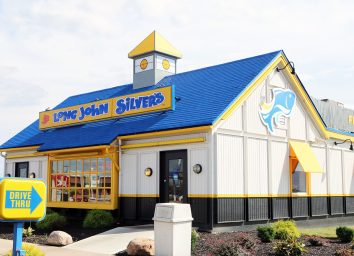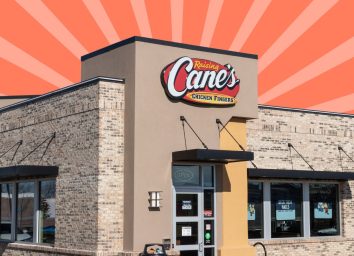These Major Mistakes Caused the Decline of America's Largest Seafood Chain
Once the number one seafood chain in the U.S., the Kentucky-based Long John Silver's has since lost half of its locations. The chain has been on a decline since at least 1989 when, in response to mounting debt, it first took its business private. In the three decades since, it's been handed off from one parent company to another and is still struggling to find its footing in the modern fast-food landscape.
Long John Silver's fall from grace was gradual. The company's heyday was a ten-year period from about 1979 to 1989, during which it grew from a footprint of one thousand units to an all-time high of 1,500 locations. Today, the seafood chain claims a little under half of that amount, with about 701 units to its name.
In terms of sales, the company has watched its hold on the quick-service seafood market steadily weaken. In its prime, Long John Silver's owned about two thirds of the entire market—an incredible feat (for comparison, a recent estimate puts McDonald's market share at just over 60%). Since then its share has decreased to about a third.
Currently, the chain is in a gentle sales nose-dive, having taken in about $70 million less this year than it did in 2017, according to Restaurant Business. Likewise, its year-over-year sales change jumped from -5.6% four years ago to -17% today—not quite the Red Lobster territory, but getting there.
It's no secret that Long John Silver's is in decline, and has been for a while. What remains unclear, and open to interpretation, is how the once-promising chain entered its current downward trend. According to Youtuber industry analyst Company Man, Long John Silver's current industry position is best understood in terms of a few key moments in the company's history, as well as some inherent qualities of the company itself.
The chain's first major blow came in 1989, when it was acquired by a group of private investors in a $620 million buyout. Although the company reached its footprint peak in that year, its unit count belied deeper financial difficulties. Having already begun to lose its prized two-thirds market share due to gradual encroachment from larger fast-food companies, and struggling with the mounting cost of fish, the chain decided to take itself private.
In the grand scheme of things, that original buyout set Long John Silver's on an unending course of acquisitions and re-sales. Its ownership by the private investment group did not significantly alter the chain's mounting debt, and when Long John Silver's declared bankruptcy in 1998, it was promptly handed off to another parent company.
Private ownership, generally, has not been good to Long John Silver's. Since its original buyout, the chain has been re-sold no fewer than three times, by the likes of A&W Restaurants and Yum! Brands—before passing back into the hands of Long John Silver's Partners LLC (who, themselves, tried to sell the brand to Texas-based company KeyCorp in 2015). Long John Silver's time with Yum! Brands was particularly disastrous, with the conglomerate yoking the seafood chain with then–sister companies A&W and Taco Bell. The co-branding effort proved mostly unsuccessful and inspired a franchisee lawsuit in 2010.
Besides its unhappy history of private ownership, Long John Silver's decline might also be attributable to something inherent in the company: its menu. From fried fish and fried chicken to hush puppies (fried balls of cornmeal), the chain's menu has always prioritized comfort and taste over health. Unsurprisingly, then, the seafood chain suffered a PR nightmare in 2013 when the Center for Science in the Public Interest named "The Big Catch," one of their core menu items, "The Worst Meal in America." As American fast-food tastes have evolved, Long John Silver's has struggled to reconcile its tradition of fried comfort food with an increasing demand for healthy eats.
That's not to say the chain hasn't managed some course corrections, though. Long John Silver's now offers numerous grilled and baked options and is careful to note on its website its compliance with sustainability practices in its purchase of fish. Pair that with the recent rebranding efforts, including store and uniform redesigns, the addition of drive-thru services, and a doubling down on online ordering, and Long John Silver's looks like it might just right its ship. We'll see how things look come International Talk Like A Pirate Day.
For more, check out:
- This Pizza Chain's Decline Is Due to "Bad" Food, Customers Say
- Steak 'n Shake Is on a Downward Spiral for These Reasons, Customers Say
- America's Largest Fast-Food Chain Is Taking a Harsh Stance Against Franchisees
And don't forget to sign up for our newsletter to get the latest restaurant news delivered straight to your inbox.









